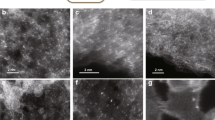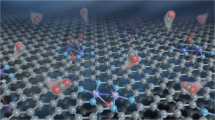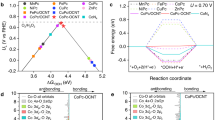Abstract
The oxygen evolution reaction (OER) is an essential anode reaction for the generation of fuels through water splitting or CO2 electroreduction. Mixed metal oxides containing Co, Fe or Ni have proved to be the most promising OER electrocatalysts in alkaline media. However, the active sites and reaction mechanisms of these catalysts are difficult to study due to their heterogeneous nature. Here we describe a general synthesis of Co-, Fe- and Ni-containing double-atom catalysts from their single-atom precursors via in situ electrochemical transformation. Characterization reveals molecule-like bimetallic active sites for these supported catalysts. For each catalyst, we propose a catalytic cycle; all exhibit bimetallic cooperation and follow a similar O–O bond-forming step. However, the mechanisms diverge in the site and source of OH− for O–O bond formation, as well as the order of proton and electron transfer. Our work demonstrates double-atom catalysts as an attractive platform for fundamental studies of heterogeneous OER electrocatalysts.
This is a preview of subscription content, access via your institution
Access options
Access Nature and 54 other Nature Portfolio journals
Get Nature+, our best-value online-access subscription
$29.99 / 30 days
cancel any time
Subscribe to this journal
Receive 12 digital issues and online access to articles
$119.00 per year
only $9.92 per issue
Buy this article
- Purchase on Springer Link
- Instant access to full article PDF
Prices may be subject to local taxes which are calculated during checkout






Similar content being viewed by others
Data availability
We declare that all data supporting the findings of this study are available in the paper and Supplementary Information files. Source data are provided with this paper.
References
Cook, T. R. et al. Solar energy supply and storage for the legacy and nonlegacy worlds. Chem. Rev. 110, 6474–6502 (2010).
Suen, N. T. et al. Electrocatalysis for the oxygen evolution reaction: recent development and future perspectives. Chem. Soc. Rev. 46, 337–365 (2017).
Song, F. et al. Transition metal oxides as electrocatalysts for the oxygen evolution reaction in alkaline solutions: an application-inspired renaissance. J. Am. Chem. Soc. 140, 7748–7759 (2018).
Dau, H. et al. The mechanism of water oxidation: from electrolysis via homogeneous to biological catalysis. ChemCatChem. 2, 724–761 (2010).
Hunter, B. M., Gray, H. B. & Muller, A. M. Earth-abundant heterogeneous water oxidation catalysts. Chem. Rev. 116, 14120–14136 (2016).
Han, L., Dong, S. & Wang, E. Transition-metal (Co, Ni, and Fe)-based electrocatalysts for the water oxidation reaction. Adv. Mater. 28, 9266–9291 (2016).
Hu, C., Zhang, L. & Gong, J. Recent progress made in the mechanism comprehension and design of electrocatalysts for alkaline water splitting. Energy Environ. Sci. 12, 2620–2645 (2019).
Zhu, C., Fu, S., Shi, Q., Du, D. & Lin, Y. Single-atom electrocatalysts. Angew. Chem. Int. Ed. 56, 13944–13960 (2017).
Sultan, S. et al. Single atoms and clusters based nanomaterials for hydrogen evolution, oxygen evolution reactions, and full water splitting. Adv. Energy Mater. 9, 1900624 (2019).
Chen, Y. et al. Single-atom catalysts: synthetic strategies and electrochemical applications. Joule 2, 1242–1264 (2018).
Bai, L., Hsu, C. S., Alexander, D. T. L., Chen, H. M. & Hu, X. A cobalt-iron double-atom catalyst for the oxygen evolution reaction. J. Am. Chem. Soc. 141, 14190–14199 (2019).
Friebel, D. et al. Identification of highly active Fe sites in (Ni,Fe)OOH for electrocatalytic water splitting. J. Am. Chem. Soc. 137, 1305–1313 (2015).
Smith, R. D. L. et al. Geometric distortions in nickel (oxy)hydroxide electrocatalysts by redox inactive iron ions. Energy Environ. Sci. 11, 2476–2485 (2018).
Carta, D., Loche, D., Mountjoy, G., Navarra, G. & Corrias, A. NiFe2O4 nanoparticles dispersed in an aerogel silica matrix: an X-ray absorption study. J. Phy Chem. C 112, 15623–15630 (2008).
Yamamoto, T. Assignment of pre-edge peaks in K-edge X-ray absorption spectra of 3d transition metal compounds: electric dipole or quadrupole? X‐Ray Spectrom. Int. J. 37, 572–584 (2008).
Colpas, G. J. et al. X-ray spectroscopic studies of nickel complexes, with application to the structure of nickel sites in hydrogenases. Inorg. Chem. 30, 920–928 (1991).
Tian, Y. et al. Speciation of nickel (II) chloride complexes in hydrothermal fluids: in situ XAS study. Chem. Geol. 334, 345–363 (2012).
Sarangi, R., Cho, J., Nam, W. & Solomon, E. I. XAS and DFT investigation of mononuclear cobalt(III) peroxo complexes: electronic control of the geometric structure in CoO2 versus NiO2 systems. Inorg. Chem. 50, 614–620 (2011).
Ekstig, B., Källne, E., Noreland, E. & Manne, R. Electron interaction in transition metal X-ray emission spectra. Phys. Scr. 2, 38 (1970).
Calas, G. & Petiau, J. Coordination of iron in oxide glasses through high-resolution K-edge spectra: information from the pre-edge. Solid State Commun. 48, 625–629 (1983).
Schmidt, H., Asztalos, A., Bok, F. & Voigt, W. New iron(III) nitrate hydrates: Fe(NO3)3·xH2O with x = 4, 5 and 6. Acta Crystallogr. C 68, i29–i33 (2012).
Burke, M. S., Kast, M. G., Trotochaud, L., Smith, A. M. & Boettcher, S. W. Cobalt-iron (oxy)hydroxide oxygen evolution electrocatalysts: the role of structure and composition on activity, stability, and mechanism. J. Am. Chem. Soc. 137, 3638–3648 (2015).
Trotochaud, L., Young, S. L., Ranney, J. K. & Boettcher, S. W. Nickel-iron oxyhydroxide oxygen-evolution electrocatalysts: the role of intentional and incidental iron incorporation. J. Am. Chem. Soc. 136, 6744–6753 (2014).
Bediako, D. K., Surendranath, Y. & Nocera, D. G. Mechanistic studies of the oxygen evolution reaction mediated by a nickel-borate thin film electrocatalyst. J. Am. Chem. Soc. 135, 3662–3674 (2013).
Bockris, J. O. M. Kinetics of activation controlled consecutive electrochemical reactions: anodic evolution of oxygen. J. Chem. Phys. 24, 817–827 (1956).
Lyons, M. E. G. & Brandon, M. P. A comparative study of the oxygen evolution reaction on oxidised nickel, cobalt and iron electrodes in base. J. Electroanal. Chem. 641, 119–130 (2010).
Bai, L., Lee, S. & Hu, X. Spectroscopic and electrokinetic evidence for a bifunctional mechanism of the oxygen evolution reaction. Angew. Chem. Int. Ed. 60, 3095–3103 (2021).
Nong, H. N. et al. Key role of chemistry versus bias in electrocatalytic oxygen evolution. Nature 587, 408–413 (2020).
Fang, Y.-H. & Liu, Z.-P. Tafel kinetics of electrocatalytic reactions: from experiment to first-principles. ACS Catal. 4, 4364–4376 (2014).
Sakaushi, K. Quantum electrocatalysts: theoretical picture, electrochemical kinetic isotope effect analysis, and conjecture to understand microscopic mechanisms. Phys. Chem. Chem. Phys. 22, 11219–11243 (2020).
Pasquini, C. et al. H/D isotope effects reveal factors controlling catalytic activity in co-based oxides for water oxidation. J. Am. Chem. Soc. 141, 2938–2948 (2019).
Fillol, J. L. et al. Efficient water oxidation catalysts based on readily available iron coordination complexes. Nat. Chem. 3, 807–813 (2011).
Chen, J. Y. et al. Operando analysis of NiFe and Fe oxyhydroxide electrocatalysts for water oxidation: detection of Fe4+ by Mossbauer spectroscopy. J. Am. Chem. Soc. 137, 15090–15093 (2015).
Diaz-Morales, O., Ferrus-Suspedra, D. & Koper, M. T. M. The importance of nickel oxyhydroxide deprotonation on its activity towards electrochemical water oxidation. Chem. Sci. 7, 2639–2645 (2016).
Martirez, J. M. P. & Carter, E. A. Unraveling oxygen evolution on iron-doped beta-nickel oxyhydroxide: the key role of highly active molecular-like sites. J. Am. Chem. Soc. 141, 693–705 (2019).
Zhang, M., de Respinis, M. & Frei, H. Time-resolved observations of water oxidation intermediates on a cobalt oxide nanoparticle catalyst. Nat. Chem. 6, 362–367 (2014).
Hung, S. F. et al. Identification of stabilizing high-valent active sites by operando high-energy resolution fluorescence-detected X-ray absorption spectroscopy for high-efficiency water oxidation. J. Am. Chem. Soc. 140, 17263–17270 (2018).
Ullman, A. M., Brodsky, C. N., Li, N., Zheng, S. L. & Nocera, D. G. Probing edge site reactivity of oxidic cobalt water oxidation catalysts. J. Am. Chem. Soc. 138, 4229–4236 (2016).
Ishizuka, T. et al. Homogeneous photocatalytic water oxidation with a dinuclear Co(III)-pyridylmethylamine complex. Inorg. Chem. 55, 1154–1164 (2016).
Wang, H. Y. et al. In situ spectroscopic identification of mu-OO bridging on spinel Co3O4 water oxidation electrocatalyst. J. Phys. Chem. Lett. 7, 4847–4853 (2016).
Man, I. C. et al. Universality in oxygen evolution electrocatalysis on oxide surfaces. ChemCatChem. 3, 1159–1165 (2011).
Risch, M. et al. Water oxidation by amorphous cobalt-based oxides: in situ tracking of redox transitions and mode of catalysis. Energy Environ. Sci. 8, 661–674 (2015).
Smith, R. D. L. et al. Spectroscopic identification of active sites for the oxygen evolution reaction on iron-cobalt oxides. Nat. Commun. 8, 2022 (2017).
Bajdich, M., Garcia-Mota, M., Vojvodic, A., Norskov, J. K. & Bell, A. T. Theoretical investigation of the activity of cobalt oxides for the electrochemical oxidation of water. J. Am. Chem. Soc. 135, 13521–13530 (2013).
Chen, S., Duan, J., Jaroniec, M. & Qiao, S. Z. Three‐dimensional N‐doped graphene hydrogel/NiCo double hydroxide electrocatalysts for highly efficient oxygen evolution. Angew. Chem. Int. Ed. 52, 13567–13570 (2013).
Lee, S., Banjac, K., Lingenfelder, M. & Hu, X. Oxygen isotope labelling experiments reveal different reaction sites for the oxygen evolution reaction on nickel and nickel iron oxides. Angew. Chem. Int. Ed. 58, 10295–10299 (2019).
Ahn, H. S. & Bard, A. J. Surface interrogation scanning electrochemical microscopy of Ni(1-x)Fe(x)OOH (0 < x < 0.27) oxygen evolving catalyst: kinetics of the ‘fast’ iron sites. J. Am. Chem. Soc. 138, 313–318 (2016).
Garrido-Barros, P., Gimbert-Surinach, C., Matheu, R., Sala, X. & Llobet, A. How to make an efficient and robust molecular catalyst for water oxidation. Chem. Soc. Rev. 46, 6088–6098 (2017).
Liu, F. et al. Mechanisms of water oxidation from the blue dimer to photosystem II. Inorg. Chem. 47, 1727–1752 (2008).
Mavros, M. G. et al. What can density functional theory tell us about artificial catalytic water splitting? Inorg. Chem. 53, 6386–6397 (2014).
Miyazato, I., Takahashi, L. & Takahashi, K. Automatic oxidation threshold recognition of XAFS data using supervised machine learning. Mol. Syst. Des. Eng. 4, 1014–1018 (2019).
Iwasawa, Y. X-ray Absorption Fine Structure for Catalysts and Surfaces Vol. 2 (World Scientific, 1996).
Filipponi, A. Statistical errors in X-ray absorption fine-structure data analysis. J. Phys. Condens. Matter 7, 9343 (1995).
Bevington, P. R. & Robinson, D. K. Data Reduction and Error Analysis (McGraw-Hill, 2003).
Stern, E. A. Number of relevant independent points in X-ray-absorption fine-structure spectra. Phys. Rev. B 48, 9825 (1993).
Charnock, J. Biological applications of EXAFS spectroscopy. Radiat. Phys. Chem. 45, 385–391 (1995).
Brillouin, L. Science and Information Theory (Courier Corporation, 2013).
Song, F. & Hu, X. Exfoliation of layered double hydroxides for enhanced oxygen evolution catalysis. Nat. Commun. 5, 4477 (2014).
Acknowledgements
This work is supported by the European Research Council (grant no. 681292) and the Ministry of Science and Technology, Taiwan (contract no. MOST 107-2628-M-002-015-RSP). We thank the following individuals from EPFL for experimental assistance: W. Ni (X-ray diffraction and Raman spectra), J. Gu (electrochemical setup for O2 Faradaic efficiency measurements), W. Lan and J. Luterbacher (N2 adsorption), P. Mettraux (XPS) and N. Gasilova (ICP–AES). Y.-F. Liao (NSRRC) is acknowledged for help with operando XAS. S. Sun (EPFL) is acknowledged for the help with processing some figures.
Author information
Authors and Affiliations
Contributions
L.B. performed the synthesis, most of the characterization, electrochemical tests and electrokinetic analysis. C.-S.H. performed the operando X-ray absorption experiments. D.T.L.A. and L.B. performed the spherical aberration-corrected HAADF–STEM measurements. All authors analysed the data. L.C.B. and X.H. wrote the paper, with inputs from other authors. H.M.C. and X.H directed the research.
Corresponding authors
Ethics declarations
Competing interests
The authors declare no competing interests.
Additional information
Peer review information Nature Energy thanks Marcel Risch and the other, anonymous, reviewer(s) for their contribution to the peer review of this work.
Publisher’s note Springer Nature remains neutral with regard to jurisdictional claims in published maps and institutional affiliations.
Supplementary information
Supplementary Information
Supplementary Figs. 1–80, Notes 1–4 and Tables 1–16.
Supplementary Data 1
Statistic source data for figures and tables in the Supplementary Information.
Source data
Source Data Fig. 1
Source data for Fig. 1a,b.
Source Data Fig. 2
Source data for Fig. 2a,d.
Source Data Fig. 3
Source data for Fig. 3c–f.
Source Data Fig. 4
Source data for Fig. 4a–e.
Source Data Fig. 5
Source data for Fig. 5.
Rights and permissions
About this article
Cite this article
Bai, L., Hsu, CS., Alexander, D.T.L. et al. Double-atom catalysts as a molecular platform for heterogeneous oxygen evolution electrocatalysis. Nat Energy 6, 1054–1066 (2021). https://doi.org/10.1038/s41560-021-00925-3
Received:
Accepted:
Published:
Issue Date:
DOI: https://doi.org/10.1038/s41560-021-00925-3
This article is cited by
-
Photo-induced synthesis of heteronuclear dual-atom catalysts
Nature Synthesis (2024)
-
Modulation in the electronic structure of Ir-rich shell on AuIr solid solution as OER electrocatalyst for PEM electrolyzer
Journal of Applied Electrochemistry (2024)
-
Atomically dispersed materials: Ideal catalysts in atomic era
Nano Research (2024)
-
Ultrathin two-dimensional medium-entropy oxide as a highly efficient and stable electrocatalyst for oxygen evolution reaction
Nano Research (2024)
-
Current Status and Perspectives of Dual-Atom Catalysts Towards Sustainable Energy Utilization
Nano-Micro Letters (2024)



